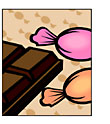|
|
Marzipan: A Sweet And Tasty History
by Marjorie Dorfman
page 2
|
 One fanciful legend about marzipan’s history comes from Spain during the siege of Toledo (850-900). As the story goes, food supplies were running low, and so the inhabitants mixed together the only available foods, namely almonds and eggs, and added some water. (This sort-of proves the life giving you lemons and lemonade theory, but to no avail.) Whether or not this is a tale for elves and their kindred, it is a fact that marzipan has delighted many cultures in many ways for hundreds of years. The Swiss covered marzipan with chocolate (but not their watches or bank executives); the Danish fashioned pink pigs for good luck and the Germans used the delectable confection to decorate their Christmas trees. One fanciful legend about marzipan’s history comes from Spain during the siege of Toledo (850-900). As the story goes, food supplies were running low, and so the inhabitants mixed together the only available foods, namely almonds and eggs, and added some water. (This sort-of proves the life giving you lemons and lemonade theory, but to no avail.) Whether or not this is a tale for elves and their kindred, it is a fact that marzipan has delighted many cultures in many ways for hundreds of years. The Swiss covered marzipan with chocolate (but not their watches or bank executives); the Danish fashioned pink pigs for good luck and the Germans used the delectable confection to decorate their Christmas trees.
Marzipan has become an important Christmas tradition in most countries and its characteristic flavor comes from bitter almonds. It is said that arsenic retains the odor of bitter almonds and therefore one could mistakenly conclude that causing the demise of a nasty marzipan lover might seem easier than plotting the death of other people. (This is not a recommended course of action as you are sure to get caught, and then who would eat all that marzipan?) Some of the sweet confection is also flavored with rosewater. A similar product, persipan, uses apricots or peach kernels in place of almonds, making foul play by poisoning even more difficult.
 Marzipan is very versatile and is often made into sweets. Most commonly, it is used to fill chocolates candies and as marzipan imitations of fruits and vegetables. (No vitamin C here; just a worthwhile dose of old Mr. Tooth Decay and Ms. Diabetic Coma.) Marzipan is also sometimes rolled into thin sheets and glazed for cake icings, particularly wedding cakes, Christmas confections and stollen. In some countries, pig shapes are very popular, especially as a traditional New Years Day treat. During Carnival season, marzipan is also utilized in Tortell (an O-shaped pastry) and in some versions of "king cake." (a new Orleans specialty). Denmark is known for its charming marzipan parties, which are part of their standard Christmas tradition. Marzipan is very versatile and is often made into sweets. Most commonly, it is used to fill chocolates candies and as marzipan imitations of fruits and vegetables. (No vitamin C here; just a worthwhile dose of old Mr. Tooth Decay and Ms. Diabetic Coma.) Marzipan is also sometimes rolled into thin sheets and glazed for cake icings, particularly wedding cakes, Christmas confections and stollen. In some countries, pig shapes are very popular, especially as a traditional New Years Day treat. During Carnival season, marzipan is also utilized in Tortell (an O-shaped pastry) and in some versions of "king cake." (a new Orleans specialty). Denmark is known for its charming marzipan parties, which are part of their standard Christmas tradition.
In Palermo, Italy, during the Christmas season, marzapane is often shaped and painted with food coloring to resemble fruits, a confection known as fruitta martorana. In Portugal, marzipan (macapao) are fruit shaped sweets made in the Algarve region. Toledo, Spain, is known for shaping marzipan into simple animal shapes (yema) filled with egg yolk and sugar. In Latin American cuisine, mazapan is traditionally eaten at holiday times.The Indian sweet, badam barfi is also from almonds and tastes similar to marzipan.
 Marzipan has made its way into pop culture jargon as well as down our welcome gullets. In business, the "marzipan layer" refers to the group of managers just below the highest level of directors or partners. The reference here is to the fact that in some cakes, a layer of marzipan lies just below the icing. Marzipan has made its way into pop culture jargon as well as down our welcome gullets. In business, the "marzipan layer" refers to the group of managers just below the highest level of directors or partners. The reference here is to the fact that in some cakes, a layer of marzipan lies just below the icing.
Wherever it comes from and however it is used, marzipan remains one of the world’s most wonderful holiday confections.
Have some for your holiday season. It may not turn out to be a lot of things you planned, but it is sure to be sweeter if do!
Happy marzipan to all and to all a good…holiday season.
Sources:
http://en.wikipedia.org/wiki/Marzip
http://marzipancandies.com/history.html
http://www.foodtimeline.org/foodcandy.html#marzipan
|
|
|
|
 |
The Chip-N-Dough Cookie Company makes delicious gourmet cookie gifts, cookie tins and gourmet cookie dough. Click Here for more information.

 We make everything by hand to ensure that old-fashioned homemade taste. With over ten "Best Cookie" awards under our belt, we are confident that our cookies are the best!
We make everything by hand to ensure that old-fashioned homemade taste. With over ten "Best Cookie" awards under our belt, we are confident that our cookies are the best!
|
A beautiful book that belongs on any pastry lover's shelf:
French Professional Pastry Series:
Decorations, Borders and Letters, Marzipan, Modern Desserts
by Roland Bilheux, Alain Escoffier

This is the fourth book in a series of four and it is a competent companion to the other three books. It deals mainly with the decoration of finished desserts, lettering and writing with a variety of ingredients (chocolate, fondant, etc), marzipan decorations, edible color painting, decoration and exhibition pieces and finished desserts among others.
|

Click for a printer friendly version of this article.
|
|